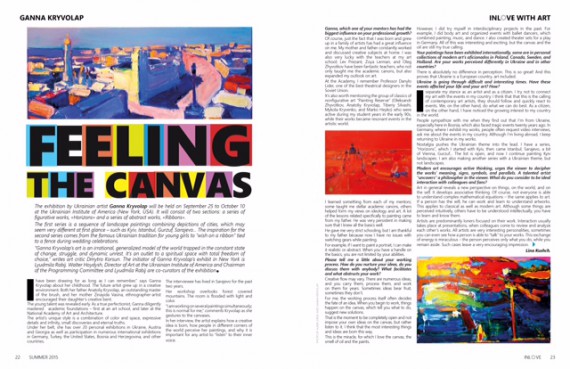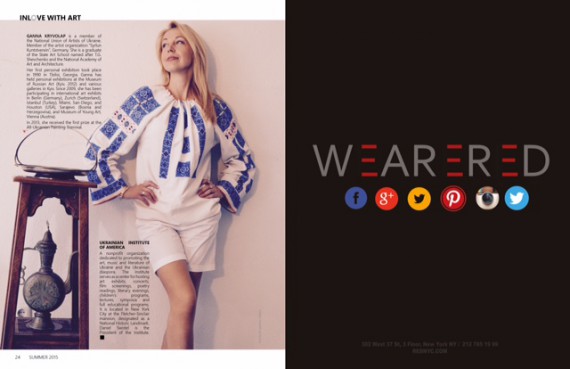Feeling the canvas


Ganna Kryvolap: "You should feel what the canvas is telling you. That’s how the best ideas are born”
The exhibition by Ukrainian artist Ganna Kryvolap will be held on September 25 to October 10 at the Ukrainian Institute of America (New York, USA). It will consist of two sections: a series of figurative works, "Horizons" and a series of abstract works, "Ribbons". The first series is a sequence of landscape paintings combining depictions of cities, which may seem very different at first glance – such as Kyiv, Istanbul, Gurzuf, Sarajevo... The inspiration for the second series comes from the famous Ukrainian tradition for young girls to “wish on a ribbon” tied to a fence during wedding celebrations. “Ganna Kryvolap’s art is an irrational, generalized model of the world trapped in the constant state of change, struggle, and dynamic unrest. It’s an outlet to a spiritual space with total freedom of choice,” writes art critic Dmytro Korsun. The initiator of Ganna Kryvolap’s exhibit in New York is Lyudmila Rabij. Walter Hoydysh, Director of Art at the Ukrainian Institute of America and Chairman of the Programming Committee and Lyudmila Rabij are co-curators of the exhibition.
“I have been drawing for as long as I can remember,” says Ganna Kryvolap about her childhood. The future artist grew up in a creative environment. Both her father Anatoliy Kryvolap, an outstanding master of the brush, and her mother Zinayida Vasina, ethnographer-artist encouraged their daughter’s creative bent. The young talent was revealed early. As a true perfectionist, Ganna diligently mastered academic foundations – first at an art school, and later at the National Academy of Art and Architecture.
The artist’s unique style is a combination of color and space, expressive details and infinity, small discoveries and eternal truths. Under her belt, she has over 20 personal exhibitions in Ukraine, Austria and Georgia as well as participation in numerous international exhibitions in Germany, Turkey, the United States, Bosnia and Herzegovina, and other countries. The interviewee has lived in Sarajevo for the past two years. Her workshop overlooks forest covered mountains. The room is flooded with light and color. “I am working on several paintings simultaneously; this is normal for me,” comments Kryvolap as she gestures to the canvases. In her interview, the artist explains how a creative idea is born, how people in different corners of the world perceive her paintings, and why it is important for any artist to “listen” to their inner voice.
- Ganna, which one of your mentors has had the biggest influence on your professional growth?
- Of course, just the fact that I was born and grew up in a family of artists has had a great influence on me. My mother and father constantly worked and discussed creative subjects at home. I was also very lucky with the teachers at my art school; Lev Prezant, Zoya Lerman, and Oleg Zhyvotkov have been fantastic teachers, who not only taught me the academic canons, but also expanded my outlook on art. At the Academy, I remember Professor Danylo Lider, one of the best theatrical designers in the Soviet Union. It’s also worth mentioning the group of classics of nonfigurative art “Painting Reserve” (Oleksandr Zhyvotkov, Anatoliy Kryvolap, Tiberiy Silvashi, Mykola Kryvenko, and Marko Heyko) who were active during my student years in the early 90s, while their works became resonant events in the artistic world. I learned something from each of my mentors; some taught me stellar academic canons, others helped form my views on ideology and art. A lot of the lessons related specifically to painting came from my father. He was very persistent in making sure that I knew all the basics well. He gave me very strict schooling, but I am thankful to my father because now I have no issues with switching gears while painting. For example, if I want to paint a portrait, I can make it realistic or abstract. When you have a handle on the basics, you are not limited by your abilities.
- Please tell me a little about your working process. How do you nurture your ideas, do you discuss them with anybody? What facilitates and what obstructs your work?
- Creative flow may vary. There are numerous ideas, and you carry them, process them, and work on them for years. Sometimes ideas bear fruit, sometimes they don’t. For me, the working process itself often decides the fate of an idea. When you begin to work, things happen on the canvas, which tell you what to do, suggest new solutions. That is the moment to be completely open and not impose your own ideas on the canvas, but rather listen to it. I think that the most interesting things and ideas are born this way. This is the miracle, for which I love the canvas, the smell of oil and the paints. However, I did try myself in interdisciplinary projects in the past. For example, I did body art and organized events with ballet dancers, which combined painting, music, and dance. I also created theater sets for a play in Germany. All of this was interesting and exciting, but the canvas and the oil are still my true calling.
- Your paintings have been exhibited internationally, some are in personal collections of modern art’s aficionados in Poland, Canada, Sweden, and Holland. Are your works perceived differently in Ukraine and in other countries?
- There is absolutely no difference in perception. This is so great! And this proves that Ukraine is a European country, art included.
- Ukraine is going through difficult and interesting times. Have these events affected your life and your art? How?
- I separate my stance as an artist and as a citizen. I try not to connect my art with the events in my country. I think that that this is the calling of contemporary art artists, they should follow and quickly react to events. We, on the other hand, do what we can do best. As a citizen, on the other hand, I have noticed the growing interest to my country in the world. People sympathize with me when they find out that I’m from Ukraine, especially here in Bosnia, which also faced tragic events twenty years ago. In Germany, where I exhibit my works, people often request video interviews, ask me about the events in my country. Although I’m living abroad, I keep returning to Ukraine in my works. Nostalgia pushes the Ukrainian theme into the lead. I have a series, “Horizons”, which I started with Kyiv, then came Istanbul, Sarajevo, a bit of Vienna, Gurzuf… The list is open, and now I continue painting Kyiv landscapes. I am also making another series with a Ukrainian theme, but not landscapes.
- Modern art encourages active thinking, urges the viewer to decipher the works’ meaning, signs, symbols, and parallels. A talented artist “uncovers” a philosopher in the viewer. What do you consider to be ideal interaction with colleagues and fans?
- Art in general reveals a new perspective on things, on the world, and on the self. It develops associative thinking. Of course, not everyone is able to understand complex mathematical equations – the same applies to art. If a person has the will, he can work and learn to understand artworks. This applies to classical as well as modern art. Although some things are perceived intuitively, others have to be understood intellectually, you have to learn and know them.
Artists are predominantly loners focused on their work. Interaction usually takes place at presentations, when colleagues come to review and analyze each other’s works. All artists are very interesting personalities, sometimes you can even see how a person is able to “talk” to your works. This exchange of energy is miraculous – the person perceives only what you do, while you remain aside. Such cases leave a very encouraging impression.
Interview by LINA KUSHCH
Additional Information
GANNA KRYVOLAP is a member of the National Union of Artists of Ukraine. Member of the artist organization “Syrlun Kuntstverein”, Germany. She is a graduate of the State Art School named after T.G. Shevchenko and the National Academy of Art and Architecture.
Her first personal exhibition took place in 1990 in Tbilisi, Georgia. Ganna has held personal exhibitions at the Museum of Russian Art (Kyiv, 2012) and various galleries in Kyiv. Since 2009, she has been participating in international art exhibits in Berlin (Germany), Zurich (Switzerland), Istanbul (Turkey), Miami, San-Diego, and Houston (USA), Sarajevo (Bosnia and Herzegovina), and Museum of Young Art, Vienna (Austria).
In 2013, she received the first prize at the All-Ukrainian Painting Triennial.
UKRAINIAN INSTITUTE OF AMERICA
A nonprofit organization dedicated to promoting the art, music and literature of Ukraine and the Ukrainian diaspora. The Institute serves as a center for hosting art exhibits, concerts, film screenings, poetry readings, literary evenings, children’s programs, lectures, symposia and full educational programs. It is located in New York City at the Fletcher-Sinclair mansion, designated as a National Historic Landmark. Daniel Swistel is the President of the Institute.
12.08.2015


